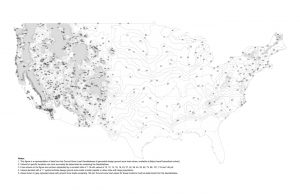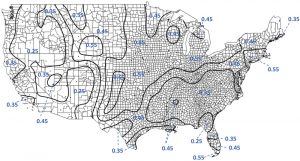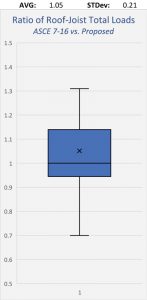Part 1
The American Society of Civil Engineer’s ASCE 7-22 load standard, Minimum Design Loads for Buildings and Other Structures, is now available. Substantive changes have been made to the snow and rain provisions within the standard. In particular, the ground snow loads have been revised to reflect more recent snow load data and reliability-targeted values. In addition, the method for estimating drifts has been revised to include a wind parameter, and the procedure for determining design rain loads has been revised to explicitly consider a ponding head. Some of the more substantive changes are discussed, along with the reasons for these changes. This article is Part 1 of a two-part series and reviews the new ground snow loads and a new winter wind parameter. Part 2 will include the other more substantive changes to the snow load provisions and the new rain load provisions.
Ground Snow Loads
The previous editions of ASCE 7 included mapped values for ground snow load (GSL) based on a statistical analysis using National Weather Service snowfall data from 1952 to 1992. This map was first included in the 1992 edition of ASCE 7 and was updated with additional information for the 1995 edition. It has remained essentially as it was in 1995 for each subsequent edition through 2016. Additionally, at the time that map was generated, the authors (researchers at the Cold Regions Research and Engineering Laboratory [CRREL] of the US Army Corps of Engineers) marked as Case Study, or CS, several significant regions, encompassing large parts of eighteen states, where significant ground elevation related changes to GSLs resulted in unreadable maps. The CS regions placed a significant burden on structural engineers to perform snow load hazard analysis, and very little guidance had been provided on how to conduct such studies.
The new GSL in ASCE 7-22 is an updated national GSL dataset in electronic and map form. The new snow loads are also based on nearly 30 years of additional snow load data since the previous study and updated procedures for estimating snow loads from depth-only measurements. The loads account for site-specific variability throughout the United States in both the magnitude and variation of the annual ground snow loads. Additionally, this approach incorporates advanced spatial mapping that significantly reduces the number and size of case study regions in mountainous areas and eliminates discontinuities in design values across state boundaries (Bean et al., 2021).
A very small fraction of the locations defined in the Geodatabase indicate that a case study must be completed to determine the ground snow load. These case-study regions are now limited and apply only to locations higher than any locally available snow measurement locations. Database ground snow load values are still provided to the user, with a warning that the estimated value lies outside the range of elevations of surrounding measurement locations. Information from local experts, from reports by Bean et al. (2021) or Buska et al. (2020), can be used to determine values at these locations.

ASCE 7-22 also includes GSL maps for each Risk Category. Each of these maps (and associated datasets) is based on reliability calculations that target the reliability objectives of Chapter 1 of ASCE 7-22. A copy of the GSL map for Risk Category II for the conterminous United States is reproduced in Figure 1. (Due to scale, Figure 1 is included in the online article at STRUCTUREmag.org.)
The adoption of reliability-targeted design ground snow loads represents a significant change from ASCE/SEI 7-16 and prior editions, which previously used ground snow loads with a 50-year mean recurrence interval (MRI). Due to climatic differences, reliability-targeted loads are adopted to address the nonuniform reliability of roofs designed according to the 50-year snow load in different parts of the country. For example, in some parts of the country, designing for the 1.6 load factor times the 50-year value does not meet the reliability targets of the standard (and, in some of these places, failures due to an underestimated ground snow load have been observed). In other places, designing for the 1.6 load factor times the 50-year value is unnecessarily conservative.

Figure 2 presents a box plot of the ratio of the new factored flat roof load to the factored ASCE 7-16 uniform loads for 65 locations in the United States. This plot indicates that while some locations changed drastically, the majority of structures have a roof load ratio (new/current) of 0.91 to 1.30, with an average of 1.12.
With the change to reliability-targeted values, the load factor on snow loads has also been revised from 1.6 to 1.0 to represent the reliability basis of the values appropriately. Snow importance factors have also been eliminated because values now are provided for each Risk Category. The 0.7 factor is intended to provide roughly equivalent strength when design follows Allowable Stress Design (ASD) procedures. For some materials, the ratio between design strength given by Load Resistance Factor Design (LRFD) procedures and design strength given by ASD procedure is 1.5. For some other materials, the ratio varies depending on the limit state being checked. The inverse of 1.5 was rounded to 0.7 for this purpose.
The same database and mapping scheme was used to prepare a 20-year mean-recurrence interval map and values for use when evaluating serviceability. The new value, 100 percent of the 20-year MRI load, is based upon the judgment of the ASCE 7 Snow and Rain Load Subcommittee and represents an increase for ASCE 7, but is less than the load specified in the International Building Code (IBC) 2021 (100 percent of the 50-year MRI load).
Winter Wind Parameter
Since the late 1980s, snow drift loads in ASCE 7 have been a function of the size of the snow source area as characterized by the ground snow load, Pg, and the upwind fetch length of the snow source area, lu. Recent research has shown that the drift load is also a function of the winter wind speeds. The addition of a winter wind parameter is intuitively appealing since one expects, with all other things being equal, that locations with relatively calm wind in winter would have smaller drifts than locations with strong winter winds.
The new relation for the drift height, hd, in ASCE 7-22 is

where γ, as before, is the snow density. The new parameter W2 is defined as the percentage of time during the winter (October through April) when the wind speed is greater than or equal to 10 mph, the nominal threshold for wind-induced snow drifting. Figure 3 presents the winter wind parameter for the lower 48 states.

Note that West of the Rockies and in the Southeast, W2 is comparatively small (typically 0.25 to 0.45), while in the Midwest and Northeast, W2 is comparatively large (typically 0.45 to 0.65). As such, the new winter wind parameter has about as strong an influence on drift surcharge load (proportional to the square of the drift height) as the ground snow and upwind fetch parameters. That is, the new ground snow load, Pg, for the lower 48 states varies from nominally 12 psf to 120 psf. Hence, its influence is nominally a factor of (120⁄12).74 or about 5.5. The upwind fetch typically varies from 100 to 1000 feet, and its influence is nominally a factor of (1000⁄100).70 or about 5. The winter wind parameter, W2, varies from 0.25 to 0.65 and hence is nominally a factor of (0.65⁄0.25)1.7 or about 5.1.
An advantage of the functional form of the relation is that there is no need for a “lower bound” drift size. That is, with the old drift relation, hd = 0.43 (lu)33 (Pg + 10).25 – 1.5, one calculates a negative drift height for low values of Pg and lu. With the new functional form, the drift height is positive for all possible combinations of the input parameters.
The most frequently asked question about the new drift approach is whether the drift loads, in general, will increase or decrease. For locations with a low W2 of 0.25, the new drift heights are typically 50% to 70% of the old ASCE 7-16 drift heights, on average about a 40% decrease. For locations with a high W2 of 0.65, the new drift height is typically 100% to 150% of the old ASCE 7-16 height, on average about a 25% increase. For locations with an average W2 of 0.45, the new drift height is typically 75% to 110% of the ASCE 7-16 height, on average about a 10% decrease. As such, one could argue that the snow drifts from ASCE 7-22 are, on average, a bit less conservative than those in ASCE 7-16.
Summary
This article summarizes some of the more substantive changes to the snow provisions of ASCE 7-22. The changes to the ASCE 7-22 ground snow loads are based upon 30 years of additional data, represent a shift away from uniform hazard to uniform risk, and significantly reduce the Case Study regions. The addition of a winter wind parameter accounts for the variability in winter wind speeds on drift loads. Part 2, in an upcoming STRUCTURE issue, will review other revisions to the snow loads, including a more accurate estimation of the horizontal extent of windward drifts, revised thermal factors Ct to account for the current trends in roof insulation and venting, and guidance on the design loads for snow capture walls. Part 2 will also discuss a significant change to Chapter 8, including adding an explicit ponding head to the rain load and a simple relation for calculation of the ponding head.■
References
Bean, B., Maguire, M., Sun, Y, Wagstaff, J., Al-Rubaye, S., Wheeler, J., Jarman, S., and Rogers, M. (2021). The 2020 National Snow Load Study. Mathematics and Statistics Faculty Publications. Paper 276.
Buska, J., Greatorex, A., and Tobiasson, W. (2020). Site-specific Case Studies for Determining Ground Snow Loads in the United States. U.S. Army Corps of Engineers Engineer Research and Development Center. ERDC/CRREL SR-20-1.
O’Rourke M, Sinh, H., Cocca J., and Williams, T., (2020) “Winter Wind Parameter for Snow Drifts,” J. Structural Engineering ASCE, ISSN 0733-9445, DOI:10.1061/(ASCE)ST.1943-541X.0002634.
